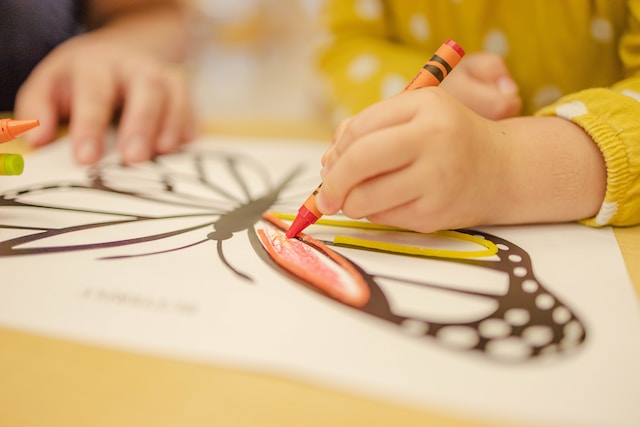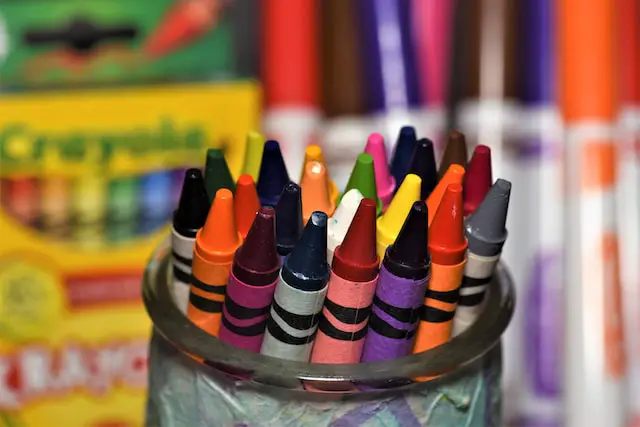Should we care about coloring skills nowadays? How can coloring compete with electronics, TV, and other high-tech toys? As an occupational therapist in a preschool setting, I’ve noticed a rise in my preschoolers’ hesitance to engage in coloring activities. Often, many children avoid coloring, preferring other tasks. Insufficient coloring practice is troubling because children benefit significantly from crayon and paper activities, which help develop age-appropriate fine motor skills.
Kindergarten is heavily focused on writing letters, words, and sentences; some children struggle with the written work expected daily. Our youngsters often need more time and opportunities spent coloring and drawing before they jump straight into writing. Developing solid coloring skills is essential to early childhood and helps kids navigate writing obstacles in elementary grades.
Benefits of Coloring Skills
Children work on multiple early skills when they engage in coloring activities:
Hand dominance: Children work on using one hand consistently for coloring. Children must develop hand preference between ages 3 and 5. Establishing one dominant hand allows children to complete tasks more efficiently and skillfully.
Bilateral Coordination: Bilateral coordination means using both sides of the body during a coloring activity. When a child works on a coloring task, their non-dominant hand (the helper’s hand) works on stabilizing paper while the dominant hand completes coloring.
Grasp on writing tool: Children work on grasping crayons or pencils with correct finger placement. Some preschoolers might need adult assistance with learning how to hold crayons functionally. A mature grasp emerges when a child grasps a crayon with a thumb and one or two fingers, with the pinky and ring finger curled in the palm.
Fine motor manipulation: This skill refers to using small hand muscles for controlled movement, especially in object manipulation. When children color, they develop precision skills for refined coloring. Kids learn and experiment using various writing tools and sizes, like wooden pencils and short or fat crayons.
Core strength: Coloring tasks are generally completed while the child is seated at a desk. Implementing creative scenarios is encouraged, such as laying on the floor (tummy down) or standing at the easel or dry-erase board. Nevertheless, children predominantly work on coloring while sitting at a desk. Maintaining balance and correct posture is critical to controlling and participating in coloring.
Hand-eye coordination: Hand-eye-coordination, also known as visual-motor coordination, is a skill that describes the simultaneous use of eyes and hands that is naturally encouraged in coloring. Younger children struggle to continuously attend to what their hands are doing; thus, short but frequent coloring opportunities benefit them most.
Upper body coordination: Children around 3 years old use their whole arm to color. As children mature, they progress to more skilled coloring. Finally, children around 4 and 5 years begin to rest their preferred arm on the paper and incorporate wrist and finger movements for coloring.
Hand strength: Coloring activities are an easy and practical way to improve hand strength. Crayons are the best writing tool for preschoolers. Crayons naturally create resistance during coloring. Thus, children learn to use appropriate pressure and strengthen their coloring endurance and the small muscles in their hands.
Prewriting: Children practice prewriting strokes. Coloring up and down, side to side, diagonally, or in circular motions, helps youngsters refine the controlled prewriting strokes necessary for shape-drawing and letter-writing.
Visual perceptual skills: Visual perceptual skills allow children to sense and interpret what they see. Children make sense of colors and patterns and learn to color within lines.
Attention: Children improve concentration over time when they work on a new task. Coloring requires the ability to attend, focus, and filter out distractions to complete the job. Coloring activities vary in the level of difficulty and sustained attention. Always start short and easy, then slowly advance to more ambitious coloring.
Creativity: Seemingly, coloring is a great way to express creativity. Younger preschoolers cannot draw detailed pictures, and expressing themselves through coloring represents their first art creations. It will spark confidence and build enthusiasm to advance artistic skills. Experimenting with many colors and patterns shifts to enjoyment, competence, and self-expression.
Cognition: Coloring requires using higher brain functions such as following directions, planning, and executing tasks. Cooperation, problem-solving, staying on task, and finishing an activity when appropriate are super preschool skills.

Development of Coloring Skills
Early Stage: Children between 1 and 2 years old use the movement of the entire arm and hold a crayon in their fists. The helping hand has no purposeful use, and often an adult stabilizes paper for a child. Toddlers dot and scribble. They are learning to stay on paper, and many mishaps occur as scribbles end up on the table.
Primary Stage: Children between 2 and 3 years start using their fingers to hold a crayon and their arm down on the table. The helper’s hand is starting to stabilize the paper. Children practice up and down, side to side, and circular scribbles. They color large pictures and stay on paper but need more control to remain within the coloring boundaries.
Intermediate Stage: Children between 3 and 5 years old develop a more mature finger grasp when holding a crayon, and their dominant hand is planted on the table. The helper’s hand starts to stabilize the paper deliberately. Children practice a variety of strokes to color the picture. They begin with aiming and scribbling in designated areas while practicing steering the crayon, starting, and stopping. They refine coloring by making vertical, horizontal, curved, and diagonal lines. Finally, they can color 3×3 pictures efficiently by coloring most of the coloring area and trying to stay within lines.
Advanced Stage: Children 5 years and beyond use a mature grasp when holding crayons. Their dominant hand rests on the paper, and precise movements of hands and fingers are developed. The helper’s hand purposely holds and places the paper. The child can color a multitude of shapes within lines.

Make Coloring Fun
- Use different types of crayons (glitter, dry-erase, short, fat, stackable, unicorn, waterdrop, rock, rocket, peanut, egg, dinosaur, key, triangular, bath, scented, star, and more)
- Make your own crayons.
- Use coloring pencils and rainbow pencils.
- Use markers for older kids — 4.5 y/o and up (I strongly recommend using crayons for early years as they naturally support grip and finger strength).
- Implement multiple body positions when coloring; coloring while lying on your tummy, using the easel, coloring outdoors with chalk, coloring under the table (tape paper under the table, lie on your back with an extended arm to color), and coloring in the bathtub with bath crayons.
- Enjoy motivating coloring pages and coloring books.
- Color cards for family members’ birthdays.
- Color with friends.
- Try coloring on different textures (sandpaper, boxes, wrapping paper, aluminum foil, and coffee filters, to list a few).
Summary
Preschool is a time of accelerated growth and development. Coloring offers a lot of valuable developmental benefits for young children. In addition, it lays the groundwork for future kindergarten success. Coloring is an everyday activity, yet it is often forgotten. Support your child’s coloring skills and admire the beautiful developmental science behind each masterpiece.
If you enjoyed this blog post, please share it with a friend!
10 Reasons Block Play Skills Are Essential for Children
5 Powerful Reasons Puzzles Skyrocket Child Development
Discover Why Messy Play Is Important
Fun Animal Walk Exercises for Children
Is My Child Ready to Write Letters?
Teaching Correct Pencil Grip to Preschoolers
*Kids Groove and Grow is a participant in the Amazon Services LLC Associates Program, as an affiliate advertising program designated to provide means for sites to earn advertising fees by advertising and linking to Amazon.com.


0 Comments